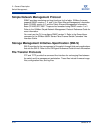
3 – Planning
Performance
59265-02 A 3-3
A
Performance
The SANbox 5800V Series switch supports class 2 and class 3 Fibre Channel
service at transmission rates of 1-, 2-, 4-, 8-,10-, or 20-Gbps with a maximum
frame size of 2148 bytes. Each Fibre Channel port adapts its transmission speed
to match that of the device to which it is connected prior to login when the
connected device powers up. Related performance characteristics include the
following:
Distance
Bandwidth
Latency
Distance
Consider the physical distribution of devices and switches in the fabric. Choose
SFP transceivers that are compatible with the cable type, distance, Fibre Channel
revision level, and the device host bus adapter. Refer to Appendix A for more
information about cable types and transceivers.
Each Fibre Channel SFP port is supported by a data buffer with a 16 credit
capacity; that is, 16 maximum sized frames. For fiber optic cables, this enables full
bandwidth over the following approximate distances:
26 kilometers at 1-Gbps (0.6 credits/Km)
13 kilometers at 2-Gbps (1.2 credits/Km)
6 kilometers at 4-Gbps (2.4 credits/km)
3 kilometers at 8-Gbps (4.8 credits/Km)
With Enterprise Fabric Suite 2007, longer distances can be spanned at full
bandwidth on SFP ports by extending credits to G_Ports, F_Ports, and E_Ports.
Each port can donate 15 credits to a pool from which a recipient port can borrow.
However, SFP ports can borrow only from other SFP ports. XPAK ports cannot
borrow or donate credits. The recipient port also loses a credit in the process. For
example, you can configure an SFP recipient port to borrow 15 credits from one
donor port for a total of 30 credits (15+15=30).


















